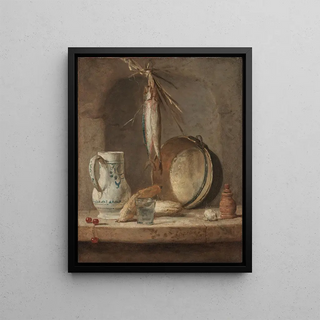Art print | Still life with herring - Jean Siméon Chardin


View from behind

Frame (optional)
In the rich and complex universe of 18th-century painting, the artwork "Art print of Fish Still Life" by Jean Siméon Chardin stands out for its apparent simplicity and its profound evocation of everyday life. This canvas, which captures with remarkable precision elements of still life, invites the viewer to contemplate not only the beauty of the depicted objects but also reflections on the passage of time and the fragility of existence. Chardin, master of chiaroscuro, manages to infuse his compositions with an intimate atmosphere, where every detail, from the herring to the kitchen utensils, seems to tell a story. Immersing oneself in this work transports us to a universe where daily life becomes art, where beauty hides in the simplest things.
Style and uniqueness of the work
Chardin's style is characterized by striking realism and meticulous attention to detail. In "Art print of Fish Still Life," the color palette chosen by the artist evokes earthy tones, enhancing the authenticity of the depicted objects. The herrings, arranged to catch the light, reveal shimmering reflections that animate the canvas. Chardin does not merely reproduce reality; he elevates it, transforming ordinary elements into a celebration of life. The composition, balanced and harmonious, demonstrates his keen sense of aesthetics. Every element, from the fish to the tableware, is carefully arranged to create a visual dynamic that draws the eye and encourages prolonged contemplation. This work also reflects the growing interest of the period in the genre of still life, while standing out through the emotional depth it conveys.
The artist and his influence
Jean Siméon Chardin, born in 1699 in Paris, is often regarded as one of the greatest masters of still life. His career, marked by a constant stylistic evolution, testifies to an unceasing quest for aesthetic truth. Chardin distanced himself from the baroque conventions of his time to embrace a more sober and introspective style. His influence on subsequent artists is undeniable; he paved the way for a new approach

Matte finish

View from behind

Frame (optional)
In the rich and complex universe of 18th-century painting, the artwork "Art print of Fish Still Life" by Jean Siméon Chardin stands out for its apparent simplicity and its profound evocation of everyday life. This canvas, which captures with remarkable precision elements of still life, invites the viewer to contemplate not only the beauty of the depicted objects but also reflections on the passage of time and the fragility of existence. Chardin, master of chiaroscuro, manages to infuse his compositions with an intimate atmosphere, where every detail, from the herring to the kitchen utensils, seems to tell a story. Immersing oneself in this work transports us to a universe where daily life becomes art, where beauty hides in the simplest things.
Style and uniqueness of the work
Chardin's style is characterized by striking realism and meticulous attention to detail. In "Art print of Fish Still Life," the color palette chosen by the artist evokes earthy tones, enhancing the authenticity of the depicted objects. The herrings, arranged to catch the light, reveal shimmering reflections that animate the canvas. Chardin does not merely reproduce reality; he elevates it, transforming ordinary elements into a celebration of life. The composition, balanced and harmonious, demonstrates his keen sense of aesthetics. Every element, from the fish to the tableware, is carefully arranged to create a visual dynamic that draws the eye and encourages prolonged contemplation. This work also reflects the growing interest of the period in the genre of still life, while standing out through the emotional depth it conveys.
The artist and his influence
Jean Siméon Chardin, born in 1699 in Paris, is often regarded as one of the greatest masters of still life. His career, marked by a constant stylistic evolution, testifies to an unceasing quest for aesthetic truth. Chardin distanced himself from the baroque conventions of his time to embrace a more sober and introspective style. His influence on subsequent artists is undeniable; he paved the way for a new approach






